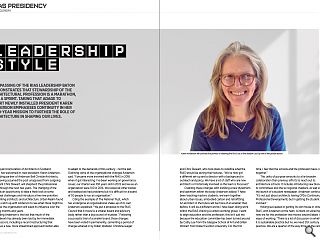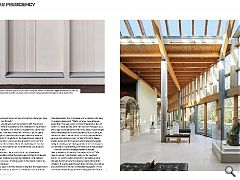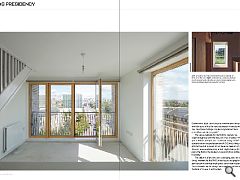RIAS presidency: Leadership Style
8 Nov 2024
The passing of the RIAS leadership baton demonstrates that stewardship of the architectural profession is a marathon, not a sprint. Taking that adage to heart newly installed president Karen Anderson emphasises continuity in her two-year mission to further the role of architecture in shaping our lives.
The Royal Incorporation of Architects in Scotland (RIAS) has welcomed its new president, Karen Anderson, a founding partner of Anderson Bell Christie Architects, who, having assumed the post unopposed from outgoing president Chris Stewart, will shepherd the professional body through the next two years. The changing of the guard is an opportunity to take a fresh look at some perennial challenges and introduce a few new priorities confronting architects and architecture. Urban Realm found time to catch up with Anderson to see what these might be and how the organisation will wield its influence over the coming months and years. Aiding Anderson is the fact that much of the groundwork has already been laid by her immediate predecessors, including a recent restructuring that promises a new, more streamlined approach better able to adapt to the demands of this century - not the last.
Outlining some of the organisational changes Anderson said: “I became more involved with the RIAS in 2018 when it got interesting. I’ve been working on governance issues; our charter was 100 years old in 2022 and we as an organisation were 100 in 2016. We looked at other bodies and realised we had problems but it is difficult for a board of 50 people to run an organisation.” Citing the example of The National Trust, which has undergone an organisational shake-up of its own Anderson explained: “We put a proposal to the RIAS Council that it move to a smaller board and advisory body rather than a big council of trustees.” Following a successful trial of a smaller board, those changes have been voted in permanently, cementing a period of change ushered in by Robin Webster, Christina Gaiger and Chris Stewart, who took steps to redefine what the RIAS should be during their tenures.
“We’ve now got a different set-up and a director with a background in outreach and policy. We have a lot of staff who are now architects or historically involved so the team is focussed,” says Anderson.
Crediting these changes with instilling a new dynamism and optimism within the body Anderson added: “I have been teaching masters students, we learn together about urban issues, embodied carbon and retrofitting. An architect in the future will be more of an enabler than before, it will be a different world. I have been doing work within the RIAS chairing a carbon working group. I want to align education and the profession; this isn’t just me because the education committee has been turned around by Cathy Lee from the Glasgow School of Art and Gillian Wishart from Robert Gordon University. For the first time, I feel that the schools and the profession have come together.”
This unity of purpose amounts to a far broader collaboration than previous efforts to reach out to architecture schools. It includes introducing new blood to committees and the six regional chapters, as well as the launch of a student newspaper. Anderson continued: “It’s not just about architects having CPDs (Continuing Professional Development) but in getting the students involved.” Having succeeded in getting its own house in order the RIAS, with Anderson at the helm, is intent on ushering in a new era for the profession that moves beyond labels to new ways of working. “There is a lot of discussion on whether it is sustainable practice but no, we need 21st century practice. We are a quarter of the way through the century and need to embrace Net Zero and climate challenge, these are my two threads.” It’s a tough ask, even for someone with Anderson’s connections and experience, but confidence is high that it can be achieved.
“I’m the first president-elect of the new structure. That has allowed me to focus, if you’ve got a whole year to prepare you can get a sense of what you want to do. Chris will be on the board as past chair and next year there will be another president-elect so there is a sense of continuity. We’re also reaching out to other partners, the students are more informed about carbon than we are.” Welcoming the opportunity to get a handle on responsibilities rather than being parachuted in, Anderson has been shadowing outgoing president Chris Stewart for the past year, chairing events in the interim before the formal handover. One aspect of RIAS electioneering that the organisation has been unable to address is the low turnout, which this time extended to the candidates with Anderson ultimately coronated unopposed.
“That’s a shame, I was annoyed about that. You want some element of support or lack of to find out what people want. I’d looked at strategy 3 or 4 years ago, so people knew what I was doing. I hope we get more candidates for the next presidency but it is difficult because it takes time and tends to attract people like me who are not running a major contract. Christina Gaiger stands out as one of the people who managed to juggle being an employee with being president but not everyone can devote so much energy when they are in that position.”
How can the RIAS engage members and get them involved so it’s not just the same old faces? “We need to support the chapters and use the members’ forum. It’s a combination of catching the national voice through the forums and the regional voices through the chapters. If you ask practitioners their priorities, one will be procurement and two will be the planning system. These are the immediate things we are tackling with the Scottish Government. If you don’t do procurement well then you won’t be able to find the next generation in employment. You have to be strategic, I’ve been cynical but these committees are working well.” The space available for the RIAS to operate has expanded greatly with the focus of A+DS on place.
“When I was at A+DS there was a bit of me that thought RIAS should concentrate on the profession and A+DS should focus on architecture but in recent times there has been much more focus on place and planning, which might change. At this point, the RIAS is the loudest voice promoting architecture in society.”
The delivery of architecture is changing, and this is a timely moment for the RIAS to lead issues ranging from zero carbon to artificial intelligence rather than reacting to them. A week may be a long time in politics but two years is the blink of an eye in architecture.
|
|





